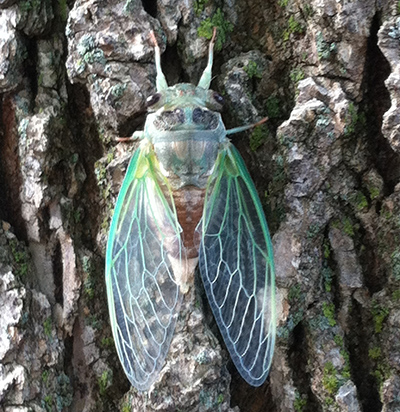Quick facts
- Adult cicadas can be identified by their power line-like sound.
- They are found in urban and rural areas wherever hardwood trees are present.
- Cicadas are active July through September.
- They are harmless to people, plants and property.
- No control is necessary.
Cicadas have sometimes been described as beetles with wings sticking out. The nymphs have been described as "beetles that turn into flies."
Cicadas are closely related to leafhoppers, planthoppers and spittlebugs.
There are two basic types of cicadas:
- Dogday cicadas (Tibicen spp.) are also called annual cicadas. They are seen every year in Minnesota.
- Periodical cicadas do not occur in Minnesota. They spend 13 or 17 years as nymphs in the ground and then emerge together in large numbers.
How to identify cicadas
Adults
- Cicadas are 1 to 1 1/2 inches long.
- They are stout with a green or brown body and black markings on the body.
- They have four, clear, fly-like wings and the first pair is much longer than their abdomen.
- The wings which are folded over their back look like a tent.
- They have very short antennae.
Nymphs
- Nymphs are immature cicadas.
- They are dark brown and look similar to the adults.
- Some people think they look like beetles because they are stout and do not have wings.
Behavior and habits of cicadas
Adults
- Cicadas are present from July to September.
- You may not see them, but you will hear the distinct humming sound they make.
- They produce a high-pitched sound during the day that resembles a power line hum.
- Only the males produce this sound to attract females.
- They hum by vibrating a membrane in an internal air chamber.
Nymphs
- It is more common to see immature nymphs than adult cicadas.
- The nymphs spend four to eight years underground, feeding on plant and tree roots, especially perennials.
- Once they come out from the ground, they climb up objects such as trees, posts, fences and the sides of buildings to molt into adults.
- When cicada nymphs molt into adults, they leave behind cast skins. The cast skin may look like an insect, but it is hollow inside.
Damage caused by cicadas
- Despite their size, cicadas are not harmful or dangerous to people, pets or property.
- While they feed on trees, they do not cause any noticeable injury.
- But, cicadas could injure trees when they use their sharp ovipositor to lay eggs in twigs.
- If you see cicadas, ignore them and they will go away on their own.
Reviewed in 2024




